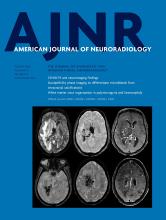Index by author
Ramanzin, M.
- Head and Neck ImagingYou have accessPretreatment DWI with Histogram Analysis of the ADC in Predicting the Outcome of Advanced Oropharyngeal Cancer with Known Human Papillomavirus Status Treated with ChemoradiationM. Ravanelli, A. Grammatica, M. Maddalo, M. Ramanzin, G.M. Agazzi, E. Tononcelli, S. Battocchio, P. Bossi, M. Vezzoli, R. Maroldi and D. FarinaAmerican Journal of Neuroradiology August 2020, 41 (8) 1473-1479; DOI: https://doi.org/10.3174/ajnr.A6695
Rapalino, O.
- Adult BrainOpen AccessEvaluation of Ultrafast Wave-CAIPI MPRAGE for Visual Grading and Automated Measurement of Brain Tissue VolumeM.G.F. Longo, J. Conklin, S.F. Cauley, K. Setsompop, Q. Tian, D. Polak, M. Polackal, D. Splitthoff, W. Liu, R.G. González, P.W. Schaefer, J.E. Kirsch, O. Rapalino and S.Y. HuangAmerican Journal of Neuroradiology August 2020, 41 (8) 1388-1396; DOI: https://doi.org/10.3174/ajnr.A6703
Ravanelli, M.
- Head and Neck ImagingYou have accessPretreatment DWI with Histogram Analysis of the ADC in Predicting the Outcome of Advanced Oropharyngeal Cancer with Known Human Papillomavirus Status Treated with ChemoradiationM. Ravanelli, A. Grammatica, M. Maddalo, M. Ramanzin, G.M. Agazzi, E. Tononcelli, S. Battocchio, P. Bossi, M. Vezzoli, R. Maroldi and D. FarinaAmerican Journal of Neuroradiology August 2020, 41 (8) 1473-1479; DOI: https://doi.org/10.3174/ajnr.A6695
Rawal, S.
- Adult BrainYou have accessFocal Leptomeningeal Disease with Perivascular Invasion in EGFR-Mutant Non-Small-Cell Lung CancerA. Dasgupta, F.Y. Moraes, S. Rawal, P. Diamandis and D.B. ShultzAmerican Journal of Neuroradiology August 2020, 41 (8) 1430-1433; DOI: https://doi.org/10.3174/ajnr.A6640
Raz, E.
- InterventionalYou have accessDural Venous Channels: Hidden in Plain Sight–Reassessment of an Under-Recognized EntityM. Shapiro, K. Srivatanakul, E. Raz, M. Litao, E. Nossek and P.K. NelsonAmerican Journal of Neuroradiology August 2020, 41 (8) 1434-1440; DOI: https://doi.org/10.3174/ajnr.A6647
- FELLOWS' JOURNAL CLUBAdult BrainOpen AccessCerebral Venous Thrombosis Associated with COVID-19D.D. Cavalcanti, E. Raz, M. Shapiro, S. Dehkharghani, S. Yaghi, K. Lillemoe, E. Nossek, J. Torres, R. Jain, H.A. Riina, A. Radmanesh and P.K. NelsonAmerican Journal of Neuroradiology August 2020, 41 (8) 1370-1376; DOI: https://doi.org/10.3174/ajnr.A6644
The authors report a unique series of young patients with COVID-19 presenting with cerebral venous system thrombosis. Three patients younger than 41 years of age with confirmed Severe Acute Respiratory Syndrome coronavirus 2 infection had neurologic findings related to cerebral venous thrombosis.
Redaelli, D.
- EDITOR'S CHOICEPediatric NeuroimagingOpen AccessCharacterizing White Matter Tract Organization in Polymicrogyria and Lissencephaly: A Multifiber Diffusion MRI Modeling and Tractography StudyF. Arrigoni, D. Peruzzo, S. Mandelstam, G. Amorosino, D. Redaelli, R. Romaniello, R. Leventer, R. Borgatti, M. Seal and J.Y.-M. YangAmerican Journal of Neuroradiology August 2020, 41 (8) 1495-1502; DOI: https://doi.org/10.3174/ajnr.A6646
The authors retrospectively reviewed 50 patients (mean age, 8.3 years) with different polymicrogyria (n = 42) and lissencephaly (n = 8) subtypes. The fiber direction-encoded color maps and 6 different white matter tracts reconstructed from each patient were visually compared with corresponding images reconstructed from 7 age-matched, healthy control WM templates. The authors demonstrated a range of white matter tract structural abnormalities in patients with polymicrogyria and lissencephaly. The patterns of white matter tract involvement are related to polymicrogyria and lissencephaly subgroups, distribution, and, possibly, their underlying etiologies.
Reynolds, M.R.
- InterventionalYou have accessReliability of the Modified TICI Score among Endovascular NeurosurgeonsD.M. Heiferman, N.C. Pecoraro, A.W. Wozniak, K.C. Ebersole, L.M. Jimenez, M.R. Reynolds, A.J. Ringer and J.C. SerroneAmerican Journal of Neuroradiology August 2020, 41 (8) 1441-1446; DOI: https://doi.org/10.3174/ajnr.A6696
Rhebergen, K.S.
- Pediatric NeuroimagingOpen AccessIntroduction of Ultra-High-Field MR Imaging in Infants: Preparations and FeasibilityK.V. Annink, N.E. van der Aa, J. Dudink, T. Alderliesten, F. Groenendaal, M. Lequin, F.E. Jansen, K.S. Rhebergen, P. Luijten, J. Hendrikse, H.J.M. Hoogduin, E.R. Huijing, E. Versteeg, F. Visser, A.J.E. Raaijmakers, E.C. Wiegers, D.W.J. Klomp, J.P. Wijnen and M.J.N.L. BendersAmerican Journal of Neuroradiology August 2020, 41 (8) 1532-1537; DOI: https://doi.org/10.3174/ajnr.A6702
Riascos, R.F.
- EDITOR'S CHOICEHead and Neck ImagingYou have accessIndentation and Transverse Diameter of the Meckel Cave: Imaging Markers to Diagnose Idiopathic Intracranial HypertensionA. Kamali, K.C. Sullivan, F. Rahmani, A. Gandhi, A. Aein, O. Arevalo, P. Rabiei, S.J. Choi, X. Zhang, R.E. Gabr and R.F. RiascosAmerican Journal of Neuroradiology August 2020, 41 (8) 1487-1494; DOI: https://doi.org/10.3174/ajnr.A6682
The purpose of this study was to investigate whether the shape (bilobed or indented appearance of the Meckel cave) or the size/volume of the Meckel cave on T2-weighted MRI could serve as a noninvasive diagnostic imaging marker for the diagnosis of idiopathic intracranial hypertension. The authors studied 75 patients with a diagnosis of IIH and 75 age-and sex-matched healthy controls. The transverse diameter of the Meckel cave was measured in the axial and coronal planes of T2-weighted MRI, and comparison was made between the 2 groups. Of 75 patients with an approved diagnosis of IIH, 57 (76%) showed an indented Meckel cave as opposed to 21 (28%) in the control group. They conclude that the shape and size of the Meckel cave can be used as sensitive and specific diagnostic imaging markers for the diagnosis of IIH.
Rigney, B.
- FELLOWS' JOURNAL CLUBAdult BrainOpen AccessCOVID-19 Is an Independent Risk Factor for Acute Ischemic StrokeP. Belani, J. Schefflein, S. Kihira, B. Rigney, B.N. Delman, K. Mahmoudi, J. Mocco, S. Majidi, J. Yeckley, A. Aggarwal, D. Lefton and A.H. DoshiAmerican Journal of Neuroradiology August 2020, 41 (8) 1361-1364; DOI: https://doi.org/10.3174/ajnr.A6650
COVID-19 infection is significantly associated with imaging confirmation of acute ischemic stroke, and patients with COVID-19 should undergo more aggressive monitoring for stroke.








